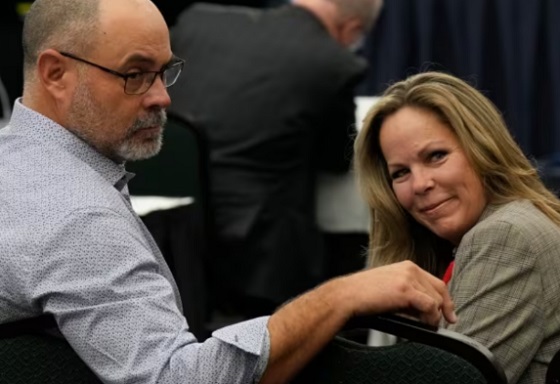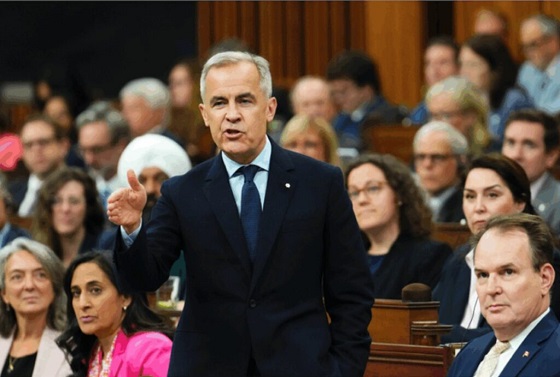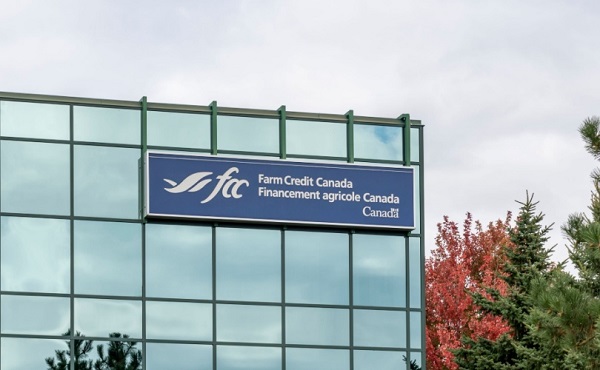To back their case, Wetscher and fellow Assistant Crown Attorney Tim Radcliffe had prepared a PowerPoint presentation that was projected onto two screens in Courtroom 5 during their final arguments. Entitled “R. v. Christopher Barber & Tamara Lich: Closing Submissions of the Crown”, the 106-slide exhibit began by listing the various charges: committing mischief, obstructing a peace officer and blocking a highway as well as counselling others to commit mischief, obstruct, block a highway and disobey a court order (the last one against Barber only). It also offered a quick guide to dozens of previous mischief, obstruction and intimidation judgements considered relevant to the case.
 An “overwhelming case”: According to the closing arguments of Assistant Crown Attorneys Siobhain Wetscher (top left) and Tim Radcliffe (top right) presented in the Ottawa Courthouse, the trial of Freedom Convoy organizers Tamara Lich and Chris Barber was not about politics, but the fact the pair “crossed the line” during the protest. (Source of bottom photo: CTV News)
An “overwhelming case”: According to the closing arguments of Assistant Crown Attorneys Siobhain Wetscher (top left) and Tim Radcliffe (top right) presented in the Ottawa Courthouse, the trial of Freedom Convoy organizers Tamara Lich and Chris Barber was not about politics, but the fact the pair “crossed the line” during the protest. (Source of bottom photo: CTV News)
Beyond a useful summary of the charges and case law, the Crown’s slideshow was also meant as one last reminder of the “significant evidence” arrayed against the Freedom Convoy pair. It thus contained numerous exhibits already submitted during the 45-day trial, including maps of the protest area, snippets from TikTok videos, transcripts from press conferences, witness testimony and interrogations as well as court orders, texts, letters, handbills, emails, Facebook posts and so on. As such, it serves as a kind of multimedia scrapbook for the entire three-week-long protest in Ottawa during January and February 2022.
And as is usually the case with scrapbooks, there were also plenty of photographs, presumably selected for the same reason as all the other evidence – because they bolster the case against Lich and Barber. In particular, the pictures are meant to provide proof of their close partnership in leading an unlawful protest and convincing others to break the law. But there’s a problem with this plan: none of the photos show either doing anything other than participating in an entirely peaceful, apparently constitutional and often quite-joyous-looking protest.
Slide 61, for example, shows the duo in winter gear hugging each other with big grins on their faces. Slide 76 has a smiling Lich explaining on TikTok that the protest is “like Canada Day on steroids.” Slide 100 is a screenshot of Lich on the verge of being arrested telling her Facebook supporters that, “I pray and hope that you will make your choices from love…we can only win this with love.”
And then there’s slide 106. The presentation’s last slide pairs a quote from Wetscher and Radcliffe with yet another picture of Lich and Barber. The text reads, “The Crown respectfully requests that the court find Mr. Barber and Ms. Lich guilty of all counts as charged.” The photo shows them together once more – again smiling broadly. This time they’re standing with Mike Stack, another protester, in front of Barber’s truck “Big Red”. If the point of this photo is to prove once and for all that Lich and Barber were engaged in a dangerous, insurrectionist conspiracy, it fails miserably.
 The Crown’s 106-slide closing presentation served as a multi-media scrapbook of the three-week-long Freedom Convoy protest, inadvertently highlighting the event’s joyousness and peacefulness. Of note, the final slide (bottom) shows a smiling Lich, Barber and fellow protester Mike Stack – while Barber’s dog Zippy enjoys the view from the driver’s seat of Barber’s truck “Big Red”.
The Crown’s 106-slide closing presentation served as a multi-media scrapbook of the three-week-long Freedom Convoy protest, inadvertently highlighting the event’s joyousness and peacefulness. Of note, the final slide (bottom) shows a smiling Lich, Barber and fellow protester Mike Stack – while Barber’s dog Zippy enjoys the view from the driver’s seat of Barber’s truck “Big Red”.
And hilariously – as a close inspection reveals Barber’s dog Zippy sitting in Big Red’s driver’s seat, mouth agape in a wild doggy smile, looking down upon the trio as if to say, “Look at me. I’m driving the truck!” For a criminal case that threatens Lich and Barber with a decade in jail for allegedly imperilling the very foundation of public order across Canada, and has consumed more than a year of precious court time, Zippy’s photo-bomb doesn’t answer the question of guilt, it raises an entirely different one.
Is this really the best the Crown can do?
Freedom’s Just Another Word for Long-Haul Trucking
On January 23, 2022, the Freedom Convoy began rolling out from Canada’s West Coast towards Ottawa, while other smaller groups of vehicles streamed westward from Quebec and other points. Three months earlier, the Government of Canada had unexpectedly announced that cross-border truckers who had not received a course of Covid-19 vaccination would have to isolate for up to two weeks when crossing the U.S.-Canada border, overturning an earlier exemption for the trucking industry. Despite furious pushback, Prime Minister Justin Trudeau refused to relent and the mandate came into effect on January 15.
‘What kind of country had Canada become?’ Lich would later write about the impact of mandatory vaccine requirements. ‘We had governments who seemed far more obsessed with promoting vaccines…than they did with the reality and the struggles of the Canadian people. Someone had to stop it.’
In response, thousands of truckers and others in cars and pickup trucks from all over the country joined the procession to make their feelings known, while thousands more waved them on from freeway overpasses and small towns along the way. Lich and Barber were involved in this movement from the beginning – creating social media accounts, setting up fundraising efforts and building an internal support structure – although the convoy itself defied organization. Lich and Barber may have been instrumental, but they were not almighty.
 Let those truckers roll, 10-4: In January 2022, thousands of vehicles from across the country converged on Ottawa to protest a dramatic change in the federal government’s Covid-19 vaccine policy for cross-border trucking. (Sources of photos: (top) Andrei Filippov/Shutterstock; (bottom) GoToVan, licensed under CC BY 2.0)
Let those truckers roll, 10-4: In January 2022, thousands of vehicles from across the country converged on Ottawa to protest a dramatic change in the federal government’s Covid-19 vaccine policy for cross-border trucking. (Sources of photos: (top) Andrei Filippov/Shutterstock; (bottom) GoToVan, licensed under CC BY 2.0)
Lich was born in Saskatoon to a Métis family and adopted as an infant. She has lived a varied life on the Prairies, working mainly as an administrator in the energy services sector and raising three children. She currently lives in Medicine Hat, Alberta with her husband Dwayne, who farms. She’s proud of her native heritage and also boasts of being a singer in a garage rock band. Lich has been politically active for many years, typically drawn to a robust defence of Western Canada’s political interests and consistently opposing the current Trudeau government. In 2018 she joined the “Yellow Vest” movement, and has also been a member of the Alberta Wildrose Party and the federal Maverick Party.
But it was the federal Liberals’ draconian response to the Covid-19 pandemic that pushed her activist inclinations into overdrive. “What kind of country had Canada become?” Lich would later write about the impact of vaccine mandates. “We had governments who seemed far more obsessed with promoting vaccines…than they did with the reality and the struggles of the Canadian people. Someone had to stop it.”
As for Barber, he hails from the small southwest Saskatchewan city of Swift Current. The 49-year-old married father of two children owns and operates a trucking firm, C.B. Trucking Limited, which specializes in long hauls of agricultural equipment. His popular TikTok account @bigred19755 provided him with a platform to complain – often impishly – about the impact of government regulation on the trucking business. As would be expected, the government’s response to the Covid-19 pandemic had a major impact on his business. Barber got the vaccine shots as required, but disagreed with how they were imposed.
 By the time they got to Ottawa: Lich (left, with husband Dwayne) of Medicine Hat, Alberta, and Barber (right, with Big Red) of Swift Current, Saskatchewan, found themselves leading the Freedom Convoy as a result of their shared opposition to federal Covid-19 vaccine mandates.
By the time they got to Ottawa: Lich (left, with husband Dwayne) of Medicine Hat, Alberta, and Barber (right, with Big Red) of Swift Current, Saskatchewan, found themselves leading the Freedom Convoy as a result of their shared opposition to federal Covid-19 vaccine mandates.
“I was at risk of losing all that hard work [building my company] to not being able to cross the border anymore,” he explained to True North News. As his frustration with Covid-19 rules grew, Barber leveraged his status on social media to become a leading voice for truckers’ outrage over vaccine policy, which in turn spurred him to help launch the Freedom Convoy. “I was angry, very angry,” Barber later explained. “The provincial mandates, the federal mandates…it seemed like it was an over-reach.” From 30,000 followers prior to the convoy, Barber’s TikTok account grew to 170,000 by the time the truckers rolled into Ottawa.
When Lich, Barber and the rest of the original convoy reached Ottawa in late January, numerous other groups and individuals unaligned with the initial organization had joined the protest for their own reasons, and with their own objectives, timelines and standards of behaviour. What most participants had in common was a deep antipathy towards the Trudeau government and a desire to make this known in the heart of the nation’s capital. Their right to do so peacefully was initially acknowledged by the Ottawa Police Service (OPS). As they arrived, OPS officers met the truckers, showed them where to park and took steps to allow them to store provisions. For the first week or so, Lich and Barber worked closely with the cops to keep emergency routes open and relations cordial. This congenial situation eventually soured, however, as the protesters lingered.
Just over two weeks later, on February 14 the federal government took the unprecedented step of invoking the Emergencies Act based on the Liberal Cabinet’s assertion that the protest constituted a Canada-wide “public order emergency” that could not be dealt with under existing laws and which involved threats of “serious violence against persons or property.” This essentially criminalized the Freedom Convey and all its supporters. Riot police then moved to physically clear the protest area, and 196 protesters in the immediate area were arrested. Another 76 individuals were arrested elsewhere in Canada at around the same time for attending other protests, including blockades at three border crossings in Ontario, Manitoba and Alberta.
 Crushing the “insurrection”: Initially accommodated by the Ottawa Police Service, the Freedom Convoy protest was later deemed a national “public order emergency”. Shown at top left, police circulate throughout the protest on February 9; top right, police hand out notices to protesters on February 17; at bottom, police confront and arrest protesters on February 18. (Sources of photos: (top left) The Canadian Press Images/Lars Hagberg; (top right) The Canadian Press/Justin Tang; (bottom left and right) Michel Elzo/Shutterstock)
Crushing the “insurrection”: Initially accommodated by the Ottawa Police Service, the Freedom Convoy protest was later deemed a national “public order emergency”. Shown at top left, police circulate throughout the protest on February 9; top right, police hand out notices to protesters on February 17; at bottom, police confront and arrest protesters on February 18. (Sources of photos: (top left) The Canadian Press Images/Lars Hagberg; (top right) The Canadian Press/Justin Tang; (bottom left and right) Michel Elzo/Shutterstock)
The federal Liberals also bullied Canada’s chartered banks into freezing the bank accounts of many people connected to the protest. Lich and Barber had their personal finances locked and both were later arrested. Lich’s single, initial charge was for “counselling to commit the offence of mischief”; Barber was charged with counselling mischief, as well as obstruction and ignoring a court order. While half-a-dozen other charges were later added to the pair’s alleged offences, mischief was the common thread that connected them to the vast majority of other protesters arrested during the crackdown.
This prevalence of mischief seems a rather surprising fact. Amidst what was supposedly a massive and violent breakdown in public order, mischief – or counselling others to be mischievous – turned out to be the most serious crime the police could detect. In Ottawa there were no assaults, no murders, no guns or bombs, no fraud or extortion, no rioting and looting, no treason. Nothing, in other words, that might have signalled that an actual (as opposed to imagined or media-manufactured) insurrection was underway or imminent.
There was, however, one criminal act that provably did occur in Ottawa during the protests. Two men attempted to set an apartment building’s entryway alight and then sealed the doors shut. This appalling and dangerous act was immediately attributed by some to the protesters. Ottawa mayor Jim Watson, for example, stated it “clearly demonstrates the malicious intent of the protesters occupying our city.” Police soon established, however, that the fire had no link to anyone connected to the Freedom Convoy.
Legal Mischief
While the term conjures up images of a misbehaving toddler, section 430 of the Criminal Code of Canada defines mischief very broadly as the willful destruction of property or interference with others’ lawful enjoyment of their own property. It should not be taken too lightly, cautions Michael Spratt, an Ottawa criminal lawyer. “Yes, mischief can be something very minor, for example drawing graffiti on a public space, or chalking a sidewalk,” Spratt says in an interview. “But mischief can also include very serious offences, for example, occupying and blockading the national capital and inflicting extreme harm on its residents, businesses, and communities.”
It seems doubtful the entirety of the chaos caused by the Freedom Convoy can be laid at the feet of Lich and Barber. Plenty of other participants deserve a large share of the blame, Velloso said, pointing especially to the police.
As an indictable offence, mischief carries a maximum penalty of 10 years in prison. Since lawyers for Lich and Barber readily admit that mischief occurred during the protest, Spratt says the only legal issue to be decided in court is whether the pair were at fault “either as a party, a participant, an encourager, an abettor or a leader of the convoy who bears some responsibility for it.” In other words, Lich and Barber could be found guilty even if they didn’t commit any mischief themselves. That would, however, require crafting a rather elaborate theory to explain a rather mundane crime.
Not every legal observer is convinced mischief best fulfills the government’s claim that it was facing an incipient violent insurrection, as is required by the Emergencies Act. According to University of Ottawa law professor Joao Velloso, most mischief charges in Canada are actually quite minor and usually punished without any jail time. Reliance on what he, unlike Spratt, views as a rather insignificant crime as the means to punish Freedom Convoy protesters seems like “a safe, bureaucratic choice for the police,” Velloso explained to The Canadian Press, adding it is “a less demanding choice in terms of police work.”
 Much ado about mischief: While Ottawa criminal lawyer Michael Spratt (left) says mischief can include “very serious charges”, University of Ottawa law professor Joao Velloso (right) observes that most mischief charges in Canada are minor and punished without any jail time. (Sources of photos: (left) Michael Spratt; (right) Errol McGihon/Saltwire)
Much ado about mischief: While Ottawa criminal lawyer Michael Spratt (left) says mischief can include “very serious charges”, University of Ottawa law professor Joao Velloso (right) observes that most mischief charges in Canada are minor and punished without any jail time. (Sources of photos: (left) Michael Spratt; (right) Errol McGihon/Saltwire)
Plus, it seems doubtful the entirety of the chaos caused by the Freedom Convoy can be laid at the feet of Lich and Barber. Plenty of other participants deserve a large share of the blame, Velloso said, pointing especially to the police. “The seriousness of the mischief during the protest was produced by lack of policing,” he asserted. This echoes the February 17, 2023 findings of the Public Order Emergency Commission chaired by Justice Paul Rouleau, which also concluded that “policing failures” – in particular, inviting the truckers into the downtown area without any long-term plan to remove them – “contributed to a situation that spun out of control.”
In deciding whether the mischief charges faced by Lich and Barber are a big deal or not, it helps to consider the fate of other Freedom Convoy protesters faced with the same charge, many of whom have been represented by the Justice Centre for Constitutional Freedoms (JCCF). Steven Vardy, for example, was arrested while driving in downtown Ottawa after the Emergencies Act had been imposed and charged with obstruction. The charge of mischief was added after police discovered Vardy had narrated a video about the protest. The Crown dropped the obstruction charge before trial, and after two days in court the judge determined the mischief charge was equally untenable, and it too was dismissed.
Christine DeCaire, another JCCF client, was arrested while standing alone on Nicholas Street in downtown Ottawa as police moved to enforce the Emergencies Act on February 18. She was acquitted at trial, a result recently confirmed after the Crown appealed. JCCF client Ben Spicer was charged with mischief, obstruction and weapons offences after police grabbed him off the street during the protest and found a pocket knife and bear spray in his backpack. Spicer was then secretly recorded in a police van. After a six-day trial, all charges were dropped because he’d been arrested unlawfully. Evan Blackman, yet another JCCF client, was charged with mischief and obstruction, and had three bank accounts frozen. Drone footage later showed Blackman holding back protesters in order to de-escalate the situation. And just before he was arrested, he could be seen singing “O Canada”. The judge dismissed all charges after a one-day trial because of evidentiary weakness; the Crown is appealing.
 Feeling mischievous: Police arrested 196 protesters in Ottawa after the Emergencies Act’s invocation, charging many with mischief and obstruction. Most had their charges later dropped or were found not guilty at trial, with the Justice Centre for Constitutional Freedoms playing a key role in these successful defences. (Source of photo: The Canadian Press/Justin Tang)
Feeling mischievous: Police arrested 196 protesters in Ottawa after the Emergencies Act’s invocation, charging many with mischief and obstruction. Most had their charges later dropped or were found not guilty at trial, with the Justice Centre for Constitutional Freedoms playing a key role in these successful defences. (Source of photo: The Canadian Press/Justin Tang)
Not every mischief case has collapsed in calamitous fashion, however. Publicity-seeking protester Tyson “Freedom George” Billings, who was not represented by the JCCF and had no direct link to Lich or Barber, pleaded guilty to counselling others to commit mischief. The other charges against him were dropped and he was sentenced to time served, about four months. And Pat King, who also garnered ample attention during the protest, is still awaiting the verdict of his mischief trial, which lasted three weeks. King and Billings were notable for their confrontational and often uncooperative relationship with the police during the protest, in sharp contrast with Lich and, for the most part, Barber.
Another exception to the raft of failed cases is the fate of the so-called “Coutts Four”. Separately from the Ottawa protest, Chris Carbert, Anthony Olienick, Chris Lysak and Jerry Morin were among the most hard-line of hundreds of participants at a tense, weeks-long standoff at the Coutts, Alberta border crossing. On February 15 the four were arrested and charged with conspiracy to murder police officers as well as other weapons and mischief offences, upon which the whole protest disintegrated. Meanwhile, up to 100 other protesters at the site were charged with provincial regulatory offences.
 Mischief ignored: The “Coutts Four” – (left to right) Chris Carbert, Anthony Olienick, Jerry Morin and Christopher Lysak – were found guilty of serious crimes arising from a tense blockade at the Coutts, Alberta border crossing. While Olienick and Carbert were also found guilty of mischief, their six-month sentences for this crime are to be served concurrently with their other, longer sentences. (Source of montage: CBC)
Mischief ignored: The “Coutts Four” – (left to right) Chris Carbert, Anthony Olienick, Jerry Morin and Christopher Lysak – were found guilty of serious crimes arising from a tense blockade at the Coutts, Alberta border crossing. While Olienick and Carbert were also found guilty of mischief, their six-month sentences for this crime are to be served concurrently with their other, longer sentences. (Source of montage: CBC)
This past February, Lysak pled guilty to possession of a weapon in an unauthorized place and Morin pled guilty to conspiracy to traffic firearms – clearly serious offences, but a vast reduction from the potential life sentences they faced. Both were sentenced to time served. More recently, Olienick and Carbert each received sentences of six-and-a-half years for various weapons offences. As for their mischief charges, each received an additional six-month sentence to be served concurrently with the other, more serious convictions. Finally, an Alberta law firm recently announced that of nearly 50 clients facing provincial charges for participating in the Coutts border protest, all either had their cases dropped or resolved for a nominal fine of $1 each.
At this point, Lich and Barber appear to be the only remaining major participants from the entire national saga who are still available to punish.
“Prosecutorial Vendetta”
While outcomes have varied, a clear pattern emerges from a survey of mischief charges laid during the Emergencies Act. Most have been dismissed or returned with a not guilty verdict after only a few days in court. A few – such as Billings’ guilty plea – have resulted in a minor sentence befitting the minor character of the crime itself. For Olienick and Carbert, their guilty verdicts for mischief had no impact on their overall jail time; they faced much more serious charges, and their mischief was essentially ignored. And the mischief trial for Pat King, who is still awaiting his verdict, was completed in three weeks.
‘There is no question whatsoever that this is a political trial,’ Goldkind states emphatically in an interview.
By comparison, the trial of Lich and Barber stretched into a 13-month epic, comprising 45 trial days. All for a collection of rather modest mischief and obstruction charges. Why would that be?
The answer, according to Ari Goldkind, a high-profile Toronto criminal defence lawyer, lies in the exact thing Wetscher tried so hard to wave away during her concluding statement: politics. “There is no question whatsoever that this is a political trial,” Goldkind states emphatically in an interview. For the Trudeau government to justify its suspension of Canadians’ civil liberties through the Emergencies Act requires an identifiable villain or two. Lich and Barber fit that bill. The length and unprecedented vigour with which the Crown has pursued the pair – Lich especially – as well as the manner in which the trial has dragged on, argues Goldkind, suggest there’s a “prosecutorial vendetta” against them.
 “Prosecutorial vendetta”: Referring to Lich and Barber, high-profile Toronto criminal defence lawyer Ari Goldkind says, “There is no question whatsoever that this is a political trial.” (Source of photo: Lorenda Reddekopp/CBC)
“Prosecutorial vendetta”: Referring to Lich and Barber, high-profile Toronto criminal defence lawyer Ari Goldkind says, “There is no question whatsoever that this is a political trial.” (Source of photo: Lorenda Reddekopp/CBC)
When Lich herself arrived in Ottawa, the diminutive, then-49-year-old Métis grandmother quickly became the public “face” of the protest. At a February 3 press conference, for example, she was introduced as “the spark that lit this fire and the leader of this organization.” And while she claims in her book Hold the Line: My story from the heart of the Freedom Convoy that such a description “wasn’t accurate,” she nonetheless admits she filled a necessary role. “I guess I found a talent I didn’t know I had before,” she writes, speculating that her time spent on stage with her band might have prepared her for all the attention. “But I mostly feel like it was guided by God,” she adds.
While the Freedom Convoy was essentially ungovernable, comprised as it was of many disparate groups and publicity-seeking, independent-minded individuals, Lich tried her best to put her own calm and reasonable stamp on the proceedings. Throughout the protest, Lich’s efforts were observably peaceful and without any apparent mal intent. One of her first acts was to set up an independent group of accountants to handle the flood of donations financing the protest to prevent any suggestion of financial impropriety. In her dealings with the police, she always tried to find common ground – a fact readily acknowledged by police witnesses during the trial. Sergeant Jordan Blonde of the OPS protest liaison team, for example, noted in his testimony that Lich was always “polite” in his dealings with her, and that the protest itself was comprised of “many different groups and factions… [and] unattached people” who were not “aligned with anybody.”
In her own interactions with the protesters, over whom she had no real control, Lich repeatedly stressed the protest’s peaceful nature and worked tirelessly to rid the movement of disreputable or hateful characters. She even cobbled together a deal with Ottawa mayor Watson to move some trucks out of the downtown area; ironically, that deal went into effect on the same day as the Emergencies Act was invoked. As her lawyer Lawrence Greenspon observed in a brief courthouse lobby interview, “She is a genuine, very pleasant person, and almost a throwback to the peace-and-love days. She was preaching all along that ‘we only wanted a peaceful, non-violent demonstration.’”
 “A throwback to the peace-and-love days”: According to her lawyer Lawrence Greenspon (at left centre, in barrister’s robe), Lich was a source of calm and grace throughout the protest and “only wanted a peaceful, non-violent demonstration.” (Source of photo: The Canadian Press/Adrian Wyld)
“A throwback to the peace-and-love days”: According to her lawyer Lawrence Greenspon (at left centre, in barrister’s robe), Lich was a source of calm and grace throughout the protest and “only wanted a peaceful, non-violent demonstration.” (Source of photo: The Canadian Press/Adrian Wyld)
Perhaps it’s this “peace-and-love” attitude that has provoked such spite towards her. Whatever the reason, the official animosity has been painfully obvious. While the physically-imposing Barber was released on bail less than 48-hours after his arrest, Lich spent 18 days awaiting bail. At her first bail hearing, Ontario Justice Julie Bourgeois claimed Lich posed such a risk to the “physical, mental and financial health and well-being” of the people of Ottawa that she denied her application outright. Only after a bail review hearing several weeks later was Lich finally released pending trial. As Goldkind points out, many extremely violent and/or repeat offenders in Canada spend no time at all in jail following their arrest. This, as many critics observe, is the result of the Liberals’ 2019 bail reform package widely derided as a “catch-and-release” policy; it apparently doesn’t apply to Lich.
When she was finally set free, Lich returned to Alberta saddled with a long list of bail conditions, including that she neither publicly support the protest nor have any contact with other protest organizers unless a lawyer is present. “After weeks of fighting for Canadians’ right[s] and freedoms, I was losing so many of mine,” she laments in Hold the Line. It was because of these efforts, however, that in June 2022 it was announced that Lich had been awarded the annual George Jonas Freedom Award, sponsored by the JCCF. Naturally enough she wanted to go to Toronto to accept the honour in person. But before she could, the Crown came after her yet again.
At her next bail hearing, the Crown argued that the decade of prison time Lich faced made her a flight risk and that she should be kept in jail until her trial was over – a move that would have resulted in several years of imprisonment, regardless of the verdict.
At a court hearing necessitated by the award (since her bail conditions also banned her from setting foot in Ontario), Crown prosecutor Moiz Karimjee argued that simply by accepting the honour, Lich had violated the terms of her bail and should be locked up again. Such an absurdity was quickly brushed aside by the presiding judge, who ruled she could travel to Ontario to attend the celebration, provided she abided by the remainder of her bail restrictions. While there, however, Lich was photographed standing beside another convoy participant, Tom Marrazzo.
 The fateful photo: When she went to Toronto to accept the 2022 George Jonas Freedom Award at a gala presentation, Lich was photographed beside fellow protester Tom Marrazzo (second from right) with lawyers standing just off-camera. This led to a Canada-wide warrant for her arrest and another 31 days in jail. (Source of photo: CBC)
The fateful photo: When she went to Toronto to accept the 2022 George Jonas Freedom Award at a gala presentation, Lich was photographed beside fellow protester Tom Marrazzo (second from right) with lawyers standing just off-camera. This led to a Canada-wide warrant for her arrest and another 31 days in jail. (Source of photo: CBC)
As she recalls in her book, “Lawyers were standing just outside the frame” when the picture was snapped, in fulfilment of her bail conditions. No matter. When the lawyer-less picture began circulating on social media after she’d returned home, Karimjee issued a Canada-wide arrest warrant in her name. Two homicide detectives were then dispatched from Ottawa to pick Lich up in Medicine Hat; the two burly detectives slapped her in leg shackles for the trip to the Calgary airport. You can’t be too careful with grandmothers.
At her next bail hearing, the Crown argued that the decade of prison time Lich faced made her a flight risk and that she should be kept in jail until her trial was over – a move that would have resulted in several years of imprisonment, regardless of the verdict. To this request, Superior Court Justice Andrew Goodman asked Karimjee if he could name a single mischief case in Canada that had resulted in a 10-year sentence. When Karimjee demurred, Goodman set Lich free once more.
In his ruling, Goodman offered his own expert opinion on the fate awaiting Lich. She “is charged with mischief and obstructing police-related offences, not sedition or inciting a riot,” the judge pointed out. “It is highly unlikely that this 49-year-old accused, with no prior criminal record and questions regarding her direct participation in the overall protests…would face a potentially lengthy term of imprisonment.”
Even if she’s found guilty, Goodman concluded, she’ll probably be sentenced to no more than time already served. All told, that amounts to 49 nights in jail. Says Goldkind: “That’s 49 nights longer in jail than someone who is caught driving three-times over the legal [alcohol] limit would likely face.” Had Karimjee gotten his way, however, she’d still be in jail – a term of 28 months and counting.
In an effort to explain the Crown’s extreme hostility towards her, Lich reveals in her book that prosecutor Karimjee has donated over $17,000 to the federal Liberal Party since 2013 and that his generosity has merited an invitation to at least one “donor appreciation” event with Trudeau himself. Similarly, Bourgeois, the judge who initially denied Lich bail, was once a Liberal candidate in an Ottawa-area riding during the 2011 federal election. In her journey through the courts to that point – a case the Crown argues is not political in any way – it was Karimjee and Bourgeoise, both with longstanding and very public Liberal sympathies, who had been the gatekeepers of a legal system intent on holding her to account for leading a massive political protest against the Liberal government. As Lich writes, “I didn’t stand a chance.”
 “I didn’t stand a chance”: According to Lich’s book Hold the Line, Crown prosecutor Moiz Karimjee (top right) made substantial donations to the Liberal Party of Canada beginning in 2013, while the judge in her initial bail hearing, Justice Julie Bourgeois (bottom right), ran as a Liberal candidate in the 2011 federal election. (Sources of photo: (top right) True North; (bottom right) juliebourgeoisgpr/YouTube)
“I didn’t stand a chance”: According to Lich’s book Hold the Line, Crown prosecutor Moiz Karimjee (top right) made substantial donations to the Liberal Party of Canada beginning in 2013, while the judge in her initial bail hearing, Justice Julie Bourgeois (bottom right), ran as a Liberal candidate in the 2011 federal election. (Sources of photo: (top right) True North; (bottom right) juliebourgeoisgpr/YouTube)
Part II of “Mischief Trial of the Century: Inside the Crown’s Bogus, Punitive and Occasionally Hilarious Case Against the Freedom Convoy’s Tamara Lich and Chris Barber” will appear on November 5.
Lynne Cohen is a journalist and non-practicing lawyer in Ottawa. She has published four books, including the biography Let Right Be Done: The Life and Times of Bill Simpson.
Source of main image: The Canadian Press/Adrian Wyld.















